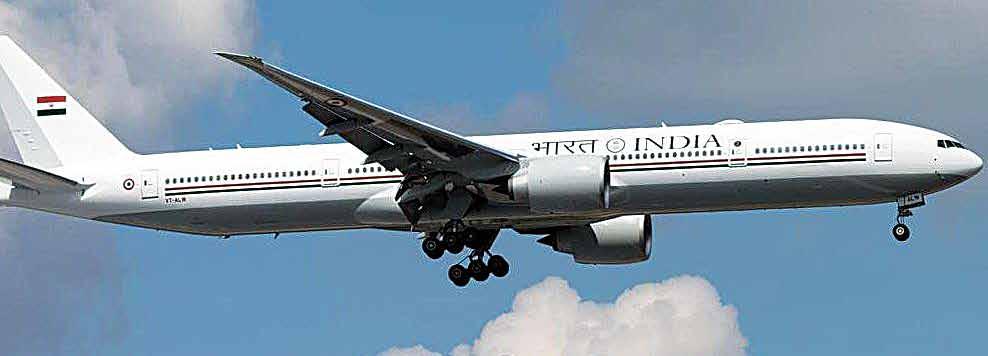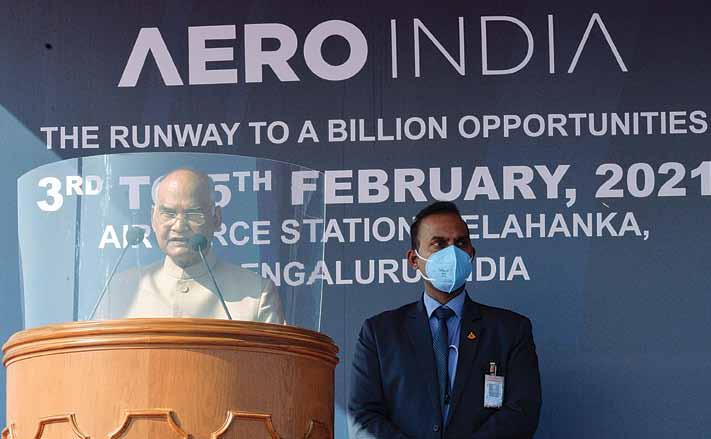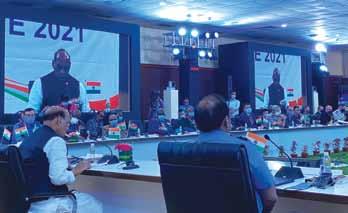
8 minute read
Aircraft Security
F-35 With ElEctronic WarFarE SuitEFor SElF-ProtEction
Advertisement
The immense popularity of Self-Protection Suites (SPS) despite their cost, indicates that the missile threat to high value aircraft is increasing
By Joseph NoroNha
In october 2020, two remarkable new aircraft arrived
in India. They are custom-built Boeing 777-300ER wide-body planes for use by Prime Minister Narendra Modi and other VVIPs. Although the Boeings are part of Air India’s fleet, they are flown by Indian Air Force (IAF) pilots. One reason for the IAF’s close involvement is that the two aircraft have ultramodern aerial defensive systems designed to avert or frustrate missile attacks. Called the Large Aircraft Infrared Countermeasures (LAIRCM) Self-Protection Suites (SPS) these systems come under a hefty $190 million deal.
In earlier days, self-protection systems were essentially meant for combat aircraft, while other aircraft simply flew out of range of missile threats. However, the growing lethality and complexity of long-range missiles means that no aircraft is safe from attack. That is why aerial SPS are becoming ubiquitous.
SURVIVAL STRATEGY
When an aircraft flies in a potentially hostile environment, a host of factors determine whether or not it will emerge unscathed. The most important factor is the aircraft’s threat detection and selfprotection capability. One essential feature is a good Radar Warning System (RWS), for instance, Raytheon’s ALR-69A, the world’s first all-digital RWS. It claims to provide long-range detection and accurate identification even in dense signal environments.

BoEing 777-300Er With SElF ProtEction SYStEMS For VViP uSE ininDia
The three basic means aircraft need to adopt to stay safe are - avoid or delay detection, jam hostile sensors and deceive the sensors to look elsewhere. Most SPS are effective either by blinding the guidance systems of incoming missiles with laser and radio frequency-based countermeasures or by confusing them with the help of chaff and flares.
When it comes to delaying detection, stealth has been the device of choice for over two decades. Combat jets such as the Lockheed Martin F-22 Raptor have their radar signature reduced in the most vulnerable frequency bands such that they become near-immune to radar detection, except at very short range. However, this obviously cannot be achieved on large aircraft such as aerial tankers and airborne command posts. Besides, even as stealth has advanced, sensors have progressed to include heat, noise, visual signature and various electro-magnetic emissions over a wide spectrum.
Jamming is a simple technique to saturate the enemy’s radar with electronic noise and so deny or at least degrade detection. However, it requires considerable power to generate this noise and an airborne platform cannot win a “power-pumping” battle against ground-based systems. The defender’s counterjamming techniques have also correspondingly advanced.
Deception is a useful military tactic and aircraft seeking to avoid detection must avoid predictable routes or operating patterns. The advent of drone swarms can also help divert the enemy’s attention away from the high-value target. Similarly, chaff can be released to confuse the attacker.
The SPS on the special Boeing 777-300ER aircraft referred to earlier, consists of a Northrop Grumman AN/AAQ 24(V)N LAIRCM, a Harris ALQ-211(V)8 Advanced Integrated Defensive Electronic Warfare Suite (AIDEWS) and a BAE Systems AN/ ALE-47 Counter-Measures Dispensing System (CMDS).
ALERT – MISSILE LAUNCH!
In case a heat-seeking missile is launched, the aircraft under threat would be alerted by onboard devices and indicators such as infrared or ultraviolet sensors that can detect the missile’s hot exhaust plume. The kinetic kill of the incoming missile may neither be effective nor advisable keeping in mind the safety of the host platform. However, various CMDS are available in the market that can release both IR flares and chaff to mislead the incoming missile. Active Electronic Warfare (EW) expendable decoys are popular options. Leonardo’s BriteCloud packs digital protection against radar-guided missiles into a tiny package that can be released from the same launcher as a standard 55 mm flare.
Most combat aircraft have some type of SPS that can assess various emerging threats to the aircraft and prioritise the appropriate response using a CMDS and a laser or microwave firing Directed Infrared Countermeasures (DIRCM) system. A DIRCM is designed to provide 360-degree protection to the host aircraft. It works by aiming a jamming laser onto the missile’s seeker, confusing its guidance system and deflecting the missile harmlessly away.
Germany-based multinational Hensoldt’s AMPS-MV (Airborne Missile Protection System with Missile Verification Sensor) is a complete stand-alone SPS from detection to protection. It offers easy integration as no avionics interface is required. It features a combination of active and passive technology to secure a significant reduction of the false alarm rate (FAR), which has long been a serious issue with airborne SPS. Since the AMPS-MV assures a near-zero FAR, the risk of running out of countermeasures (flares) is greatly reduced. This also improves aircraft survivability especially during night time by avoiding unintended tell-tale flare deployment. Various subsystems can be integrated with the AMPS-MV including a Missile Warning System (MWS), a Laser Warning System (LWS), an RWS, a CMDS, and a DIRCM.
Another cutting-edge system is the J-Multi-Spectral Infrared Countermeasure (J-MUSIC) DIRCM. Produced by Israel’s ELBIT, it has been successfully integrated with the Airbus A-330 MultiRole Tanker Transport (MRTT) as well as the Airbus A-400M transport aircraft.
WHO WILL WIN – THE CAT OR THE MOUSE?
The immense popularity of SPS despite their cost indicates that the missile threat to high-value aircraft is increasing. At present, the equation between the attacker and the defender is reasonably balanced. However, in the medium term, it is likely that aircraft will be at some disadvantage in this cat-and-mouse game because they can only carry a limited amount of defensive equipment as compared to ground-based systems. As missiles and their guidance systems become ever more lethal and capable, the manufacturers of self-protection systems must constantly strive to remain abreast. SP

The PresidenT, shri ram naTh Kovind addressing aTThe valedicTory funcTion of aero india-21, aTair force sTaTion, yelahanKa, in Bengaluru on feBruary 5, 2021.
NatioN’s first maN coNcluded the first hybrid airshow
Display of the defence prowess, strengthening the self-reliance mission, modernisation, global reach and inclusivity highlighted during Aero India 2021
By Ayushee ChAudhAry
After three days of hybrid interactions, conferences,
deals, displays and air show, the valedictory function of the 13th edition of the Aero India 2021 was graced by President of India, Ram Nath Kovind and the first lady, Savita Kovind. The show was physically attended by over 600 exhibitors and by another 108 in the virtual mode of the world’s first ever hybrid show. Around 3,000 Business-2-Business (B2B) meetings were conducted during the event and representatives from 63 foreign countries were said to be in attendance.
In his address the President had said, “India is not just a


(lefT)defence minisTer rajnaTh singh inauguraTing The india Pavilion; (righT) defence minisTer rajnaTh singh addressing The inaugural session of chiefs of The air sTaff conclave aTaero india 2021.
(lefT)rear admiral eileen lauBacher, defence aTTache, usemBassy, new delhi sPeaKing aBouT india-us defence ParTnershiP (righT)KeynoTe address By v.l. KanTha rao, direcTor general (acquisiTions), minisTry of defence, india


market, but a land of immense opportunities for the whole world, including in the defence sector. The government has taken a number of policy initiatives aimed at placing India among the top nations in the defence sector with twin objectives of self-reliance and export promotion. He had sadded that the government is focused on promoting the ‘Ease of Doing Business’ to encourage manufacturers to set up units in India. The reforms initiated in India in the last six years offer unprecedented opportunities to investors and private companies in the defence and aerospace sectors.
Aero India 2021 stood as a living proof of India’s ever-growing strength in the defence and aerospace sectors at the global level and the event exhibited that the global confidence in India’s capabilities is growing steadily, Kovind had noted during his concluding remarks. Referring to the Conclave of Defence Ministers of Indian Ocean Region (IOR), on the theme of ‘Enhanced Peace, Security, and Co-operation in the Indian Ocean’, which was organised on the margins of Aero India 2021, the President had said that India has always been an ardent advocate of universal peace and development and it is important that IOR nations focus on fostering political, economic, cultural and defence co-operation.
The Defence Minister Rajnath Singh had remarked that Aero India offered a unique platform to Indian private and public sector industry and global original equipment manufacturers to forge partnerships and showcase products to potential customers. “Despite the COVID-19 challenges, Aero India was successful in attracting 16,000 visitors physically and close to 5 lakh people virtually. He said the large number of Memorandum of Understandings (MoUs) concluded during the event and orders of over 203 crores bagged by MSMEs were an indication of the exhibition’s success.
The first ever IOR Defence Ministers’ Conclave during the airshow was attended by ministers and delegates from 26 countries, and the discussions focused on synergising efforts of IOR countries in the Indian ocean and expressed belief that there would be a higher level of cooperation amongst IOR countries on peace and security in the future. A conclave of Chiefs of Air Staff was also organised to pursue the objectives of collaborative security for the region and beyond. “The iDEX ‘Start-up Manthan’, the 6th India-Russia Military Industrial Conference and various seminars held on wide ranging themes would help in achieving twin objectives of Atmanirbharata and Defence exports. In the last few years the Armed Forces had given significant support to the mission of ‘Aatmanirbhar Bharat’ and played an important role in promoting domestic industry. Aero India 2021 would help in achieving the target of a turnover of `1,75,000 crore, including exports of `35,000 crore in aerospace and defence goods & services by the year 2024,” the Defence Minister had stated during the valedictory session of the show.
Singh had also significantly remarked that self-reliance does not mean isolation from the world or to act as a closed economy but it rather promotes globalisation by making India a more competitive player on the global stage and by inviting global companies. “India will invest around 130 billion US dollars towards enhancing security by military modernisation in the next 7-8 years,” he had added. SP










